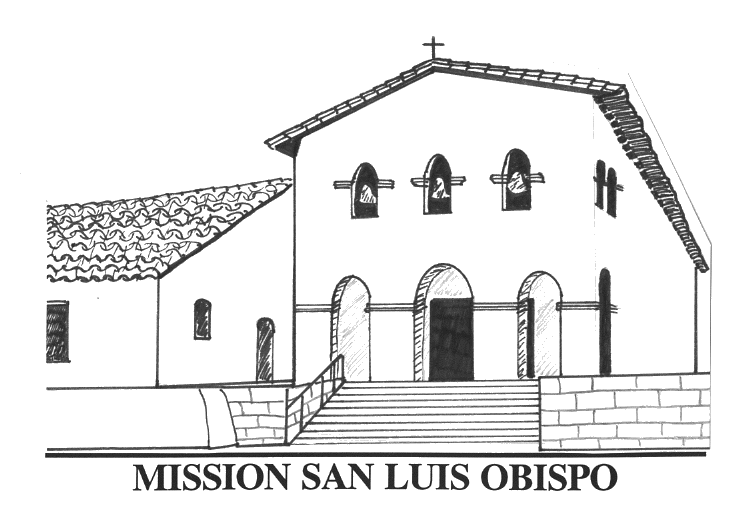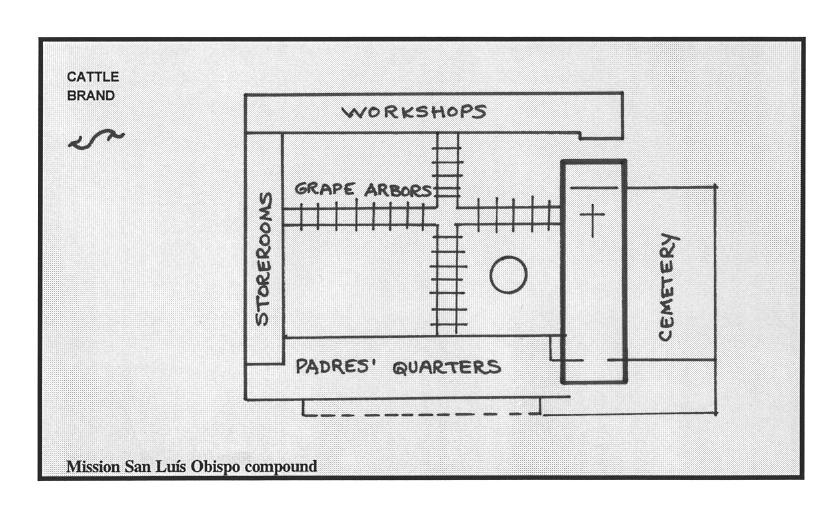| ||||
|
| ||||
|
MISSION
SAN LUIS OBISPO DE TOLOSA
782
Monterey Street (P.O.
Box 1483)
San
Luis Obispo, CA
93406
Established: September 1, 1772
By: Father Junípero Serra, Franciscan missionary, President of the missions.
Order: 5th of the 21 missions.
Location: Halfway between the north and south ends of the mission chain, in an inland valley surrounded by mountains.
Named: For Saint Louis, a Franciscan and Bishop of Toulouse (France) in the early 14th century; son of King Charles II of Naples and nephew of Louis IX of France.
California Historical Landmark No.325
DESIGN OF THE MISSION
Church: Adobe building, about 125 feet long, 25 feet wide. Tile roof. Floor is mezcla (stone and mortar).
Style: Simple "mission" style, noted for the combination of belfry and vestibule (entry hall). Porches around the courtyard have round pillars with square openings, unlike the arches of other missions.
Walls: Adobe covered with plaster and whitewash.
Bell Tower: The bell tower, with its three bells hanging in uniform arched openings, serves also as the vestibule or entry to the church. Bells were made in 1818 in Peru, and were recast in 1878.
Mission Compound: Built around a traditional patio, divided into four sections by grape arbors. The church was on the north side of the square, living quarters for the priests on the east side, workshops and storehouses on the west and south.
Mission Grounds: Mission noted for the wines, olive oil, fruits and vegetables grown there, but even more for roofing tiles and cloth. Large flocks of sheep produced wool which was spun into yarn and then woven into cloth. Heavy wool blanket material was used to make serapes (cloaks or ponchos); light weight cloth for other clothing was made in a quantity to be supplied to other missions.
To Mission San Luís Obispo goes credit for establishing the use of red tile roofs that became a symbol of the California missions. Though first used at Mission San Antonio de Padua, roofing tiles were perfected and produced on a large scale by Mission San Luís Obispo. The roofing tiles were patterned on those remembered by the padres from their days in Spain. Water and local clay was mixed by having horses walk around in circles through the clay, which was then formed over curved wooden molds of tree trunks, dried in the sun and baked in a kiln. The tiles were about 22 inches in length and tapered from 12 to 20 inches in width. Water came from a nearby stream, and was used to power a gristmill.

EARLY HISTORY
1769 Governor Portolá, on his way from San Diego north to Monterey, crossed a valley where grizzly bears were eating the tule roots in the marshy ground; named it La Cañada de los Osos (Valley of the Bears) and returned to the valley to get meat for the soldiers and missions.
1772 Father Serra founded the mission; left the next day to return to San Diego, leaving Father José Cavaller in charge of building a chapel, barracks, priests' house and workshops of logs and tules.
1773 Group of Spanish emigrants, including four families, arrived.
1776 Tule thatched roofs set on fire by flaming arrows; many buildings destroyed.
1792-1794 Construction of present church with help from master Mexican craftsmen; made of adobe with tile roof.
1796 Father Luís Antonio Martínez in charge of mission for next 34 years; very popular with the Chumash Indians of this area.
1819 Quadrangle of buildings around the courtyard completed.
1820 Bell tower added, built of adobe.
1832 Bell tower damaged by earthquake; rebuilt in stone.
1835 Mission secularized, property valued at $70,000 taken by the government.
1845 Mission lands sold for $510.
1853 Bandit Joaquin Murieta camped in the mission garden.
1859 Mission returned to Catholic Church.
MISSION SAN LUIS OBISPO TODAY
During the 1880's Mission San Luís Obispo was "modernized" by a well-meaning parish priest, who tried to make the mission look like a New England church. Wooden siding was placed over the adobe and a steeple was added to the building. The bell tower and the vestibule were torn down. The inside was also modernized, with wood flooring covering the original mezcla floor. For over 50 years there was little to remind one of the original Spanish mission.
Authentic restoration was started in 1933 under the leadership of Father John Harnett, who removed the wood siding and the steeple, and rebuilt the bell tower and vestibule. The three bells were returned to their niches.
Restoration of the church interior to its 1794 condition continued during the 1940's. The original beamed ceiling was uncovered. The altar used in the early days is there, as well as the original statue of Saint Louis above the altar and the original baptismal font.
Mission San Luís Obispo serves as a parish church. A large wing has been added to the original church, doubling the seating capacity. The original padres' quarters, with eleven columns along its walkway, has been restored as a museum.
The city of San Luis Obispo calls itself The City with a Mission, in honor of its beginnings as a Spanish mission. A town plaza faces the restored mission church, and each year a fiesta is held to celebrate the founding.
